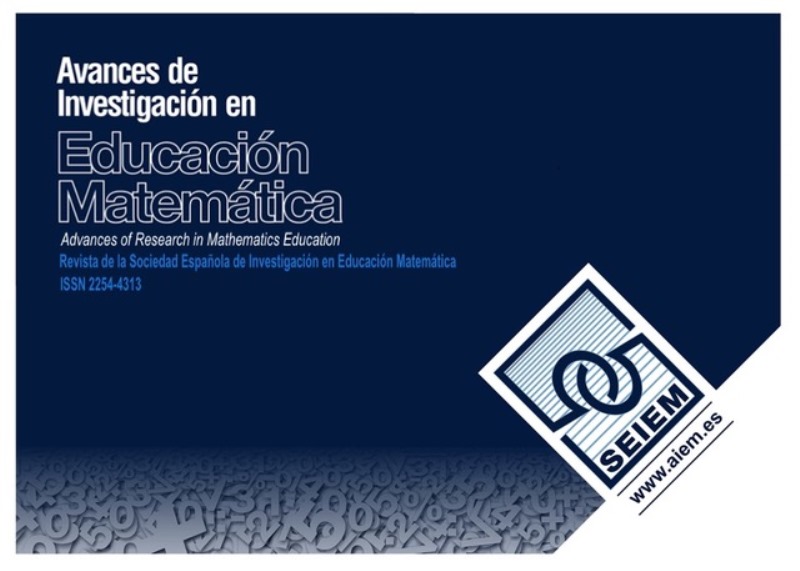Problem Posing and the Use of AI: Motivational Beliefs Among Pre-service Primary School Teachers
DOI:
https://doi.org/10.35763/aiem28.7546Keywords:
Problem posing, Motivational beliefs, Chatbots, Artificial intelligence, Teaching skillsAbstract
Problem posing is central to mathematics education and, like other practices, is challenged by teachers’ motivational beliefs and the use of artificial intelligence (AI). In this study, we applied a proprietary instrument, the ForPro-IA questionnaire, to assess the perceptions as problem formulators and AI users of 175 prospective primary school teachers. As a result, we found that participants found problem formulation more useful and cost-effective compared to the use of AI. The design, validation and application of the instrument are also presented as an original contribution to the field.
Downloads
References
Ball, D., Thames, M. H., & Phelps, G. (2008). Content knowledge for teaching: What makes it special? Journal of Teacher Education, 59(5), 389–407. https://doi.org/10.1177/0022487108324554
Bandura, A. (1997). Self-efficacy: The exercise of control. W. H. Freeman.
Baumanns, L., & Rott, B. (2022). The process of problem posing: Development of a descriptive phase model of problem posing. Educational Studies in Mathematics, 110(2), 251–269. https://doi.org/10.1007/s10649-021-10136-y
Berryhill, A., Chandler, L., Bondurant, L., & Sapkota, B. (2024). Using ChatGPT as a thought partner in writing relevant proportional reasoning word problems. Connections, 4(33).
Blömeke, S., Gustafsson, J.-E., & Shavelson, R. J. (2015). Beyond dichotomies: Competence viewed as a continuum. Zeitschrift für Psychologie, 223(1), 3–13. https://doi.org/10.1027/2151-2604/a000194
Burgos, M., Tizón-Escamilla, N., & Chaverri, J. (2024). A model for problem creation: Implications for teacher training. Mathematics Education Research Journal. https://doi.org/10.1007/s13394-023-00482-w
Cai, J., & Hwang, S. (2020). Learning to teach through mathematical problem posing: Theoretical considerations, methodology, and directions for future research. International Journal of Educational Research, 102, 101391. https://doi.org/10.1016/j.ijer.2019.01.001
Cai, J., Koichu, B., Rott, B., & Jiang, C. (2024). Advances in research on mathematical problem posing: Focus on task variables. The Journal of Mathematical Behavior, 76, 101186. https://doi.org/10.1016/j.jmathb.2024.101186
Cai, J., & Rott, B. (2024). On understanding mathematical problem-posing processes. ZDM – Mathematics Education, 56(1), 61–71.
https://doi.org/10.1007/s11858-023-01536-w
Cankoy, O., & Özder, H. (2017). Generalizability theory research on developing a scoring rubric to assess primary school students’ problem posing skills. Eurasia Journal of Mathematics, Science and Technology Education, 13(6), 2423–2439. https://doi.org/10.12973/eurasia.2017.01233a
Carrillo-Yañez, J., Climent, N., Montes, M., Contreras, L. C., Flores-Medrano, E., Escudero-Ávila, D., Vasco, D., Rojas, N., Flores, P., Aguilar-González, Á., Ribeiro, M., & Muñoz-Catalán, M. C. (2018). The mathematics teacher’s specialised knowledge (MTSK) model. Research in Mathematics Education, 20(3), 236–253. https://doi.org/10.1080/14794802.2018.1479981
Creswell, J. W. (2012). Educational research: Planning, conducting, and evaluating quantitative and qualitative research. Pearson.
Eccles, J. S., & Wigfield, A. (2002). Motivational beliefs, values, and goals. Annual Review of Psychology, 53, 109–132. https://doi.org/10.1146/annurev.psych.53.100901.135153
Einarsson, H., Lund, S. H., & Jónsdóttir, A. H. (2024). Application of ChatGPT for automated problem reframing across academic domains. Computers and Education: Artificial Intelligence, 6, 100194. https://doi.org/10.1016/j.caeai.2023.100194
Embid, S., & Perdomo-Díaz, J. (2024a). Herramientas digitales en la formulación de problemas de fracciones por futuros maestros de primaria. En N. Adamuz-Povedano, E. Fernández-Ahumada, N. Climent, & C. Jiménez-Gestal (Eds.), Investigación en Educación Matemática XXVII (pp. 201–208). SEIEM.
Embid, S., & Perdomo-Díaz, J. (2024b). Evaluación del potencial de distintos chatbots para la formulación de problemas matemáticos. Formación del Profesorado e Investigación en Educación Matemática, 16, 41–58.
Embid, S., Perdomo-Díaz, J., & Giaconi, V. (2024). Cuestionario ForPro-IA. OSF Storage. https://doi.org/10.17605/OSF.IO/Y45RW
Giaconi, V., Perdomo-Díaz, J., Cerda, G., & Saadati, F. (2018). Prácticas docentes, autoeficacia y valor en relación con la resolución de problemas de matemáticas: Diseño y validación de un cuestionario. Enseñanza de las Ciencias, 36(3). https://doi.org/10.5565/rev/ensciencias.2351
Grundmeier, T. A. (2015). Developing the problem-posing abilities of prospective elementary and middle school teachers. En F. M. Singer, N. F. Ellerton, & J. Cai (Eds.), Mathematical problem posing: From research to effective practice (pp. 411–431). Springer. https://doi.org/10.1007/978-1-4614-6258-3_20
Hernández, A., Perdomo-Díaz, J., & Camacho-Machín, M. (2019). Mathematical understanding in problem solving with GeoGebra: A case study in initial teacher education. International Journal of Mathematical Education in Science and Technology, 51(2), 208–223. https://doi.org/10.1080/0020739X.2019.1587022
Hwang, G.-J., & Tu, Y.-F. (2021). Roles and research trends of artificial intelligence in mathematics education: A bibliometric mapping analysis and systematic review. Mathematics, 9(6), 584. https://doi.org/10.3390/math9060584
Jiménez Ávila, W. J., & Sosa Guerrero, L. (2024). Creencias y actuación en el aula de los formadores de profesores de matemáticas. Enseñanza de las Ciencias, 42(3), 185–202. https://doi.org/10.5565/rev/ensciencias.5985
Kilpatrick, J. (1987). Problem formulating: Where do good problems come from? En A. H. Schoenfeld (Ed.), Cognitive science and mathematics education (pp. 123–147). Lawrence Erlbaum Associates.
Kuhail, M. A., Alturki, N., Alramlawi, S., & Alhejori, K. (2023). Interacting with educational chatbots: A systematic review. Education and Information Technologies, 28(1), 973–1018. https://doi.org/10.1007/s10639-022-11177-3
Leavy, A., & Hourigan, M. (2022). The Framework for Posing Elementary Mathematics Problems (F-PosE): Supporting teachers to evaluate and select problems for use in elementary mathematics. Educational Studies in Mathematics, 111(1), 147–176. https://doi.org/10.1007/s10649-022-10155-3
Lupiáñez, J. L., Olivares, D., & Segovia, I. (2024). Examining the role played by resources, goals and orientations in primary teachers’ decision-making for problem-solving lesson plans. ZDM – Mathematics Education, 56(6), 1153–1167.
Marbán, J. M., Palacios, A., & Maroto, A. (2020). Desarrollo del dominio afectivo matemático en la formación inicial de maestros de primaria. Avances de Investigación en Educación Matemática, 18, 73–86. https://doi.org/10.35763/aiem.v0i18.286
Martínez-Rizo, F. (2012). Procedimientos para el estudio sobre las prácticas docentes: Revisión de la literatura. RELIEVE – Revista Electrónica de Investigación y Evaluación Educativa, 18(1), 1–22.
McNeish, D. (2018). Thanks coefficient alpha, we’ll take it from here. Psychological Methods, 23(3), 412.
Montes, M., Chico, J., Martín-Díaz, J. P., & Badillo, E. (2024). Mathematics teachers’ specialized knowledge mobilized through problem transformation. The Journal of Mathematical Behavior, 73, 101132. https://doi.org/10.1016/j.jmathb.2024.101132
National Council of Teachers of Mathematics. (2014). Principles to actions: Ensuring mathematical success for all. Author.
Noster, N., Gerber, S., & Siller, H.-S. (2024). Pre-service teachers’ approaches in solving mathematics tasks with ChatGPT. Digital Experiences in Mathematics Education, 10, 543–567. https://doi.org/10.1007/s40751-024-00155-8
Parra, V., Sureda, P., Corica, A., Schiaffino, S., & Godoy, D. (2024). Can generative AI solve geometry problems? Strengths and weaknesses of LLMs for geometric reasoning in Spanish. International Journal of Interactive Multimedia and Artificial Intelligence, 8(5), 65. https://doi.org/10.9781/ijimai.2024.02.009
Rafi, I., & Sugiman, S. (2019). Problem posing ability among prospective mathematics teachers. Pythagoras: Jurnal Pendidikan Matematika, 14(2), 188–198. https://doi.org/10.21831/pg.v14i2.29976
Remillard, J. T., Reinke, L. T., & Kapoor, R. (2019). What is the point? Examining how curriculum materials articulate mathematical goals and how teachers steer instruction. International Journal of Educational Research, 93, 101–117. https://www.sciencedirect.com/science/article/pii/S0883035518305810
Reeve, J. (2015). Understanding motivation and emotion (6th ed.). Wiley.
Revelle, W. (2019). psych: Procedures for psychological, psychometric, and personality research [R package]. https://cran.r-project.org/package=psych
Richard, P. R., Vélez, M. P., & Van Vaerenbergh, S. (Eds.). (2022). Mathematics education in the age of artificial intelligence: How artificial intelligence can serve mathematical human learning. Springer.
https://doi.org/10.1007/978-3-030-86909-0
Rosseel, Y. (2018). lavaan: Latent variable analysis [R package].
https://cran.r-project.org/package=lavaan
Saadati, F., Cerda, G., Giaconi, V., Reyes, C., & Felmer, P. (2019). Modeling Chilean mathematics teachers’ instructional beliefs on problem solving practices. International Journal of Science and Mathematics Education, 17(5), 1009–1029. https://doi.org/10.1007/s10763-018-9897-8
Schindler, M., & Bakker, A. (2020). Affective field during collaborative problem posing and problem solving: A case study. Educational Studies in Mathematics, 105(3), 303–324. https://doi.org/10.1007/s10649-020-09973-0
Schorcht, S., Buchholtz, N., & Baumanns, L. (2024). Prompt the problem – Investigating the mathematics educational quality of AI-supported problem solving by comparing prompt techniques. Frontiers in Education, 9. https://doi.org/10.3389/feduc.2024.1386075
Schober, P., Boer, C., & Schwarte, L. A. (2018). Correlation coefficients: Appropriate use and interpretation. Anesthesia & Analgesia, 126(5), 1763. https://doi.org/10.1213/ANE.0000000000002864
Shultz, K. S., Whitney, D., & Zickar, M. J. (2020). Measurement theory in action: Case studies and exercises (3rd ed.). Routledge. https://doi.org/10.4324/9781003127536
Silver, E. A. (1994). On mathematical problem posing. For the Learning of Mathematics, 14(1), 19–28.
Son, J. W., & Diletti, J. (2017). What can we learn from textbook analysis? In J.-W. Son, T. Watanabe, & J.-J. Lo (Eds.), What matters? Research trends in international comparative studies in mathematics education (pp. 3–32). Springer. https://doi.org/10.1007/978-3-319-51187-0_1
Stoyanova, E., & Ellerton, N. F. (1996). A framework for research into students’ problem posing in school mathematics. Technology in Mathematics Education, 4(7), 518–525.
Voica, C., Singer, F. M., & Stan, E. (2020). How are motivation and self-efficacy interacting in problem-solving and problem-posing? Educational Studies in Mathematics, 105(3), 487–517. https://doi.org/10.1007/s10649-020-10005-0
Wardat, Y., Tashtoush, M., Alali, R., & Saleh, S. (2024). Artificial intelligence in education: Mathematics teachers’ perspectives, practices and challenges. Iraqi Journal for Computer Science and Mathematics, 5(1), 60–77. https://doi.org/10.52866/ijcsm.2024.05.01.004
Downloads
Published
How to Cite
Issue
Section
License
Copyright (c) 2025 Sara Embid, Josefa Perdomo-Díaz, Valentina Giaconi

This work is licensed under a Creative Commons Attribution 4.0 International License.
The articles published in this journal are under a license Creative Commons: By 4.0 España from number 21 (2022).
Authors who publish with this journal agree to the following terms:
- Authors retain copyright and keep the acknowledgement of authorship.
- The texts published in this journal are – unless indicated otherwise – covered by the Creative Commons Attribution 4.0 international licence. You may copy, distribute, transmit and adapt the work, provided you attribute it (authorship, journal name, publisher) in the manner specified by the author(s) or licensor(s). The full text of the licence can be consulted here: http://creativecommons.org/licenses/by-nc/4.0.
- Authors are able to enter into separate, additional contractual arrangements for the non-exclusive distribution of the journal's published version of the work (e.g., post it to an institutional repository or publish it in a book), with an acknowledgement of its initial publication in this journal.
- Authors are permitted and encouraged to post their work online (e.g., in institutional repositories or on their website) prior to and during the submission process, as it can lead to productive exchanges, as well as earlier and greater citation of published work (See The Effect of Open Access).
Funding data
-
Agencia Estatal de Investigación
Grant numbers PID2022-139007NB-I00 -
Agencia Estatal de Investigación
Grant numbers PREP2022-000959 -
Agencia Nacional de Investigación y Desarrollo
Grant numbers NCS2021_014 -
Agencia Nacional de Investigación y Desarrollo
Grant numbers AFB240004 -
Centro de Modelamiento Matemático, Facultad de Ciencias Físicas y Matemáticas
Grant numbers FB210005









